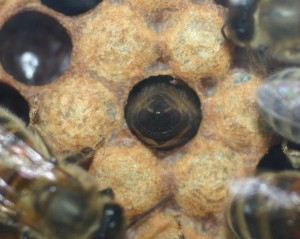Blog – bees, beekeeping & other sticky subjects
Shy, retiring, but very vocal!
At last! It’s been a full week since the queen in the observation hive emerged from her cell. Because I couldn’t find her I had begun to think that the cell had been torn down and that they were working on some other queen cell that I couldn’t see.
Over the past week, I have looked and looked for her with no success. Then this morning I heard her piping, then cawing a bit like a seagull, but a few octaves lower. Recognising the sound, I immediately stopped work and with one glance at the hive spied her immediately.
But it was quite some time before I was able to photograph her. She is very elusive, very dark and often has her bottom in a cell.
She has started to lay and I think today is her first day of egg production. I’m not quite sure what all the piping has been about. Maybe it was some sort of celebration. It’s been going on and off all day! It could even be from another queen still in a cell that isn’t obvious!
Turlough, Vita’s Guest Beekeeper Blogger
Winter losses in the USA state-by-state
Here are the state-by-state honeybee 2013/14 winter colony losses in the USA :
However this blogpost by Sebastian Owen of Vita suggests that the stats this year may need careful interpretation.
Local college takes to beekeeping
Right on Vita’s doorstep, a college has taken to beekeeping.
On a rooftop less a few hundred metres from Vita’s HQ, Basingstoke College of Technology has installed two hives. We went to visit them this week.
Sited just a few weeks ago, the nucleii colonies are growing fast and one is already confident enough to be producing queen cells. With a mentor from Basingstoke Beekeepers, the five-strong college team is enthusiastic and attracting the interest of different departments in the college.
They’ve chosen as their apiary site the rooftop of the engineering department. It is nicely sheltered and they have erected fine mesh netting to make sure the bees fly outwards over the town and not backwards into the air conditioning machinery where maintenance men might otherwise find all-to-quick fixes for any problems.

Up on the roof. BCOT beekeepers Lauren, Tim and Vanessa with Pete (left) of the local beekeeping association. Casual observers can watch the bees safely from this side of the mesh.
The bees, headed up by Carniolan queens are beautifully tempered and reputed to do well except in rather hot climates– no worries there then!
The big question now is will the colonies grow large enough to bring in honey before the nectar flow stops. The first supers were added today and there’s plenty of good forage around, so here’s hoping!
Since this could well be a year when varroa thrives, the bees were treated early with Apistan and will receive Apiguard treatments in preparation for winter.
We will keep you informed of progress and so will they on Twitter @bcotbuzz and Facebook.
Heater bees or hygienic bees?
As I patiently wait the appearance of a queen in the observation hive (it seems that the first queen cell was torn down and two others started, albeit at a late larval stage), I’m becoming interested in the heater bees.
I always thought that bees with their heads in a cell were simply cleaning it. That’s not necessarily so.
Jurgen Tautz in The Buzz about Bees tells that bees, heads down in cells and vibrating are actually heater bees maintaining the brood at the optimum temperature. He reckons that the control of the brood nest temperature is equivalent to power usage of 20W (watt) and that if bees could channel that energy into a light bulb, they could light up their dark hive world!
Turlough, Vita’s Guest Beekeeper Blogger
Do bees go bananas?
 In theory ripe bananas should have some effect on bees, but there was no apparent reaction from mine so far.
In theory ripe bananas should have some effect on bees, but there was no apparent reaction from mine so far.
Ripe bananas give off isoplentylacetate, the main component of the honeybee alarm pheromone. (I picked up this factoid in Jurgen Tautz’s wonderful book, The Buzz about Bees: Biology of a Superorganism.) So, in theory, they might be expected to become a bit stroppy in the vicinity of a nicely blackened banana.
Immediately after a thunderstorm I put one at the entrance to a queen-making nuke, but they didn’t seem to care much at all. Not even the dead bee thrown out before the storm.
Has anyone noticed their bees going bananas?
(By coincidence, I see this topic has just been raised today on Bee_L Listserv)
Turlough, Vita’s Beekeeper Blogger




